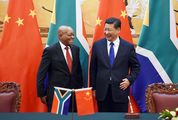THE masters in management (MiM) degree, once the best-kept secret of European business schools, is becoming the star of 21st-century business education.
Though still a passport to the boardrooms of France and northern Europe, it is also proving to be the saviour of many North American business schools and a tool to build international reputations in countries as far afield as China.
In the US, where applications to MBA programmes have fallen, masters degrees have provided a welcome source of revenue while giving those leaving undergraduate degrees a leg up in the job market during the great recession.
As such, the MiM degree in the US was frequently designed for liberal arts graduates from the parent university.
In Indiana, at Mendoza College, for example, which started its programme two years ago, 40% of students are still graduates of the parent University of Notre Dame, says Mary Goss, senior director of graduate business programmes.
"What the masters in management has done is open up those undergraduate recruiters to other students on campus."
This growing recognition and acceptance of the degree in the US is also increasing the country’s popularity as a destination for MiM graduates from Europe, says Leila Guerra, executive director of early career programmes at London Business School, which launched its MiM degree in 2009.
While big-brand US schools such as Fuqua, Kellogg and Michigan Ross chart the popularity of this new breed of business degrees, others are more concerned about the knock-on effect on other programmes.
Mark Vandenbosch, associate dean for programmes at Canada’s Ivey Business School at Western University, says the plethora of degrees on the market may mean graduates of the degree find themselves competing for jobs with those from undergraduate business programmes.
He says masters need to have a real distinguishing feature or "spike", as he calls it, to differentiate them.
"We can’t continue to create students unless there are recruiters ready to accept them."
The growing international acceptance of the masters in management means that for French business schools, which have dominated the Financial Times MiM ranking since its inception in 2005 with their Grandes Écoles programmes, the degree can increasingly attract high fee-paying international students to France.
Schools such as Skema are even exporting the degree to the US. The school will go one step further this year when its masters in international business will be taught in Brazil through an agreement with executive education specialist Fundação Dom Cabral.
"We need to internationalise for our growth. In France, the fees are frozen," says Alice Guilhon, dean of Skema.
"It’s very difficult to think about growth in only (the French) market."
Skema is one of several French schools to have set up in China and to promote the MiM there. Kedge Business School, for example, has worked with Renmin University in Beijing to develop a three-year programme after which graduates receive a bachelors degree from Renmin and a MiM from Kedge, says Kedge dean Thomas Froehlicher.
"We have to reinvent business education for the 21st century.
"The French Grande École is a product of the 20th century," he says.
Not all Chinese business school deans are convinced of the value of the MiM. Most masters degrees in China have an academic focus and are often prerequisites for PhD programmes, says Zhou Lin, dean of Antai College at Shanghai Jiao Tong University.
As a result, China’s ministry of education rules that schools cannot charge high fees. Antai, for example, charges 98,000 yuan ($15,333) for its MiM but 208,000 yuan for its full-time MBA and 568,000 yuan for its executive MBA.
In addition, the Chinese government requires masters programmes to be at least two years long, which means many Chinese travel overseas to take a one-year degree, he says.
More promising for Chinese schools are MiMs designed to attract international students and that are outside the quota system and have fewer restrictions on fees, says Prof Zhou. Two years ago, Antai launched just such a programme.
"Although the initial number was modest, we enrolled 38 students from about 20 countries last year," he says.
"We expect to have more than 50 students out of 120-plus applicants this autumn."
The tentative growth of the MiM in China is at odds with what is happening in India.
The Post Graduate Programme (PGP), a two-year pre-experience business masters that largely mirrors the French Grandes Écoles programmes, has long been the flagship programme of the elite Indian Institutes of Management (IIM). However, all that is changing.
At IIM Ahmedabad, arguably the most prestigious business school in India, there are plans to push up the entry age and work experience of students, says Ajay Pandey, dean for programmes.
"We would hope that in the next six to seven years [work experience] would be a given. We want to get 80%-85% [of students] with work experience at least," he says.
The move to a post-experience degree will also result in the PGP being renamed an MBA. The confusion in India is unlikely to hamper the growing recognition of the MiM, however.
As more graduates move up the corporate hierarchy, they will begin to recruit graduates in their own image, says Leila Guerra at LBS. "MiMs recruit other MiMs. As they do so, the MiM brand will become more established.
"For me, the successful moment will be when I can go out and say, ‘I have an MiM’, and people will understand it the same way they do the MBA."
Financial Times

Bank of England governor Mark Carney delivers a public speech at the Cass Business School in London, the UK. The masters in management degree is growing in international appeal. Picture: REUTERS/SANG TAN
THE masters in management (MiM) degree, once the best-kept secret of European business schools, is becoming the star of 21st-century business education.
Though still a passport to the boardrooms of France and northern Europe, it is also proving to be the saviour of many North American business schools and a tool to build international reputations in countries as far afield as China.
In the US, where applications to MBA programmes have fallen, masters degrees have provided a welcome source of revenue while giving those leaving undergraduate degrees a leg up in the job market during the great recession.
As such, the MiM degree in the US was frequently designed for liberal arts graduates from the parent university.
In Indiana, at Mendoza College, for example, which started its programme two years ago, 40% of students are still graduates of the parent University of Notre Dame, says Mary Goss, senior director of graduate business programmes.
"What the masters in management has done is open up those undergraduate recruiters to other students on campus."
This growing recognition and acceptance of the degree in the US is also increasing the country’s popularity as a destination for MiM graduates from Europe, says Leila Guerra, executive director of early career programmes at London Business School, which launched its MiM degree in 2009.
While big-brand US schools such as Fuqua, Kellogg and Michigan Ross chart the popularity of this new breed of business degrees, others are more concerned about the knock-on effect on other programmes.
Mark Vandenbosch, associate dean for programmes at Canada’s Ivey Business School at Western University, says the plethora of degrees on the market may mean graduates of the degree find themselves competing for jobs with those from undergraduate business programmes.
He says masters need to have a real distinguishing feature or "spike", as he calls it, to differentiate them.
"We can’t continue to create students unless there are recruiters ready to accept them."
The growing international acceptance of the masters in management means that for French business schools, which have dominated the Financial Times MiM ranking since its inception in 2005 with their Grandes Écoles programmes, the degree can increasingly attract high fee-paying international students to France.
Schools such as Skema are even exporting the degree to the US. The school will go one step further this year when its masters in international business will be taught in Brazil through an agreement with executive education specialist Fundação Dom Cabral.
"We need to internationalise for our growth. In France, the fees are frozen," says Alice Guilhon, dean of Skema.
"It’s very difficult to think about growth in only (the French) market."
Skema is one of several French schools to have set up in China and to promote the MiM there. Kedge Business School, for example, has worked with Renmin University in Beijing to develop a three-year programme after which graduates receive a bachelors degree from Renmin and a MiM from Kedge, says Kedge dean Thomas Froehlicher.
"We have to reinvent business education for the 21st century.
"The French Grande École is a product of the 20th century," he says.
Not all Chinese business school deans are convinced of the value of the MiM. Most masters degrees in China have an academic focus and are often prerequisites for PhD programmes, says Zhou Lin, dean of Antai College at Shanghai Jiao Tong University.
As a result, China’s ministry of education rules that schools cannot charge high fees. Antai, for example, charges 98,000 yuan ($15,333) for its MiM but 208,000 yuan for its full-time MBA and 568,000 yuan for its executive MBA.
In addition, the Chinese government requires masters programmes to be at least two years long, which means many Chinese travel overseas to take a one-year degree, he says.
More promising for Chinese schools are MiMs designed to attract international students and that are outside the quota system and have fewer restrictions on fees, says Prof Zhou. Two years ago, Antai launched just such a programme.
"Although the initial number was modest, we enrolled 38 students from about 20 countries last year," he says.
"We expect to have more than 50 students out of 120-plus applicants this autumn."
The tentative growth of the MiM in China is at odds with what is happening in India.
The Post Graduate Programme (PGP), a two-year pre-experience business masters that largely mirrors the French Grandes Écoles programmes, has long been the flagship programme of the elite Indian Institutes of Management (IIM). However, all that is changing.
At IIM Ahmedabad, arguably the most prestigious business school in India, there are plans to push up the entry age and work experience of students, says Ajay Pandey, dean for programmes.
"We would hope that in the next six to seven years [work experience] would be a given. We want to get 80%-85% [of students] with work experience at least," he says.
The move to a post-experience degree will also result in the PGP being renamed an MBA. The confusion in India is unlikely to hamper the growing recognition of the MiM, however.
As more graduates move up the corporate hierarchy, they will begin to recruit graduates in their own image, says Leila Guerra at LBS. "MiMs recruit other MiMs. As they do so, the MiM brand will become more established.
"For me, the successful moment will be when I can go out and say, ‘I have an MiM’, and people will understand it the same way they do the MBA."
Financial Times





















